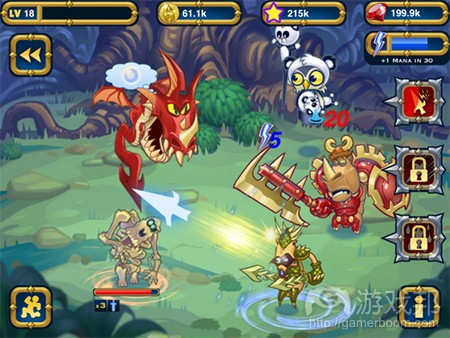Appy品牌总监探讨免费社交游戏的盈利渠道
作者:Jeff Scott
最近,Appy Entertainment首款社交游戏《SpellCraft School of Magic》刚刚突破200万次下载量,鉴于激烈竞争的市场环境,这可以算是个不错的成绩。
日前,Appy Entertainment品牌总监Paul O’Connor在其下款社交游戏《Animal Legends》发行前夕,接受采访并介绍了公司从免费游戏中盈利的方法。
社交性
对移动游戏而言,多人模式的社交元素有多重要?
Paul回复道:“我们认为多人模式是一个关键特性。”
“它不仅可以突出游戏的特点,同时可以吸引玩家再次进入游戏进程。”
但移动多人游戏的构造方式必须有别于主机类型,对吧?
“移动多人游戏应拥有独特的平台与题材。如果我们制作的是适合Xbox或PS3这类主机平台的《Animal Legends》,那么它一定会有自身的独特体验。对移动玩家而言,这类游戏的构造方式应符合玩家的玩法,比如玩家可以每天多次进入游戏,以及在短时间内获胜。”
Paul继续提到:“开发者应在设计游戏初期便应考虑到多人模式,而不是在后期添加多人元素。《Animal Legends》的代号是“Questing with Friends”,它表明了社交性的重要性。”
盈利的重要性
那么,免费游戏的盈利模式又会如何呢?根据Appy制作《SpellCraft》的经验,你认为哪些方式可行?哪些不可行?
Paul回复道:“我们并不是这一方面的专家。虽然我们的游戏取得了不错的收益,但我们希望玩家可以主动付费,而不是被迫付费。我们一直避免涉及付费障碍,避免控制玩家体验游戏。”
“我认为,关键是游戏应提供大量付费渠道。不仅仅是虚拟货币,游戏还应允许玩家购买虚荣物品,如果他们想要付费取得快速通关,游戏应允许这种行为。”
多人模式是否有利于游戏盈利,该模式是否会频繁吸引玩家重返游戏进程?
“我们的秘密武器是,多人模式有利于鼓励玩家宣传游戏。我们希望,这种宣传方式最终至少可以让游戏获取可观的收益水平。”
我喜欢与开发者们探讨《CSR Racing》这款免费游戏。我个人认为,该游戏的强迫消费模式表现尤其明显。当然,你不能否定它的成功,但我好奇它是否以牺牲游戏品质为代价实现盈利,因为其本质是付费取胜。
Paul评价称“《CSR Racing》是竞争激烈环境中的杰出之作,虽然它属于单人模式,并且它催生出付费取胜模式。然而,它更应归属于PvP游戏,即玩家在游戏中的重点是打败其他玩家。”
分析
获取可观收益的一大关键便是了解自己的用户类型,他们的玩法,以及他们的付费方式。
Appy是如何利用这些分析结果制作出更出色且更具盈利性的游戏呢?
“我们会追踪用户类型,但不是以个体形式。通常,我们会把用户分为几大类型,然后根据某类用户的玩法需求更改游戏的某些方面。无论如何,我们寄希望于从每种用户类型中获取些许收益。”
“我们也会遇到为游戏支付一些费用的用户,这主要基于他们对游戏的喜爱。同时,我们还发现不少用户会向他人宣传自己下载的游戏,这同样有助于我们盈利。”
“接着,我们还发现喜欢回应游戏广告,或是浏览广告的用户。最终,这些方式都有助于游戏盈利。”
假如,你正打算发行一款出色的游戏,那么哪个元素是免费游戏获取理想收益的关键?
“我们会调查参数,比如,了解人们正在进行的活动,他们的体验方式。分析是关键。通过分析,你可以清楚明了用户的玩法,届时,你可以基于用户类型与当前趋势制作游戏。”(本文为游戏邦/gamerboom.com编译,拒绝任何不保留版权的转载,如需转载请联系:游戏邦)
Stateside: Appy Entertainment on SpellCraft, CSR Racing, and the surging social gaming scene
by Jeff Scott
San Francisco-based Jeff Scott is the founder of 148Apps.com, which was recently acquired by PocketGamer.biz publisher Steel Media.
Appy Entertainment is just a few shy of reaching two million downloads for their first social game, SpellCraft School of Magic – a pretty good return considering the competition.
And now, on the eve of the launch of its next social game Animal Legends, we caught up with Paul O’Connor – the firm’s brand director – to talk free to play social games and how the studio addresses the monetisation of them.
Socially speaking
I asked Paul about the importance of multiplayer social aspects in free to play mobile games.
“We see multiplayer in some form as a critical feature,” he offered.
“Not only does it distinguish the game, but make it much more compelling for the user to come back to the game.” But mobile multiplayer has to be built differently over console, right?
“It needs to be unique to the style of the platform and game. If we were building Animal Legends for a console like Xbox or PS3, the multiplayer would be completely different. For mobile players it needs to be built to work with the way people play, many times per day and in short bursts.”
He continues, “Multiplayer needs to be in the design from the beginning, not an afterthought. For this game, it’s codename was Questing with Friends if that gives any indication about how important we thought it was.”
Money matters
How about monetising free to play games. From Appy’s experience with SpellCraft, what works and what doesn’t?
Paul responds, “We are far from experts in the area. Our games have monetised well, but we want players to pay in the game because they want to, not because they have to. We stay away from pay walls and methods that keep players from playing the games.
“I think the key is to provide lots of ways for people to pay you. Not only in-game currency, but also vanity items, and if they want to pay their way to the end quickly, so be it.”
Does multiplayer help with monetising a game, and does it get people coming back to play more often? “Our secret weapon is that multiplayer has incentivised players to spread the game. In the end we are hoping it will spread at least to a level that it monetised well.”
One thing I like to discuss with developers of free to play games is CSR Racing. Personally, I think the push to pay is especially egregious in that game. While you can’t argue with the success it’s had, I wonder if it’s at the expense of quality gameplay. It’s essentially pay to win.
Paul comments “CSR is a game that thrives on a very competitive environment – even if it is a single-player one – and a pay-to-win model thrives there. It is even more the case in PvP games where players get very focused on beating each other.”
Eye on analytics
One key of good monetisation is knowing your user types, how they play, and how they pay.
How does Appy use those analytics to make the game better and more profitable?
“We keep track of user types, but never individual users. Generally we can put users in certain buckets and change the game in one of a few ways to react to how that user bucket plays. In one method or another we hope to earn a bit from each user type.
“We run into users who spend a few bucks in the game just because they like the game. We also see users that spread the word about the game which gets downloads, that also helps us.
“Then we also see users who like to respond to offers or just see ads. Each way helps monetise the game, in the end.”
If there were one thing, assuming you had a great game to start with, what’s the one thing to monetise a free to play game well?
“Look at metrics, see what people are doing, how they are playing. Analytics are key. With analytics you can watch how users play the game and you can react based on those user segments and based on general trends.”(source:pocketgamer)









































 闽公网安备35020302001549号
闽公网安备35020302001549号